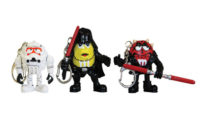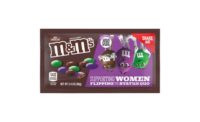Color, Brand Characters Star In M&M’S World New York
Chocolate, most would agree, is a very good thing. And as the folks at Mars Retail Group would be inclined to point out, it’s even better in color.
Thus the vibrant hues of red, blue, yellow and green
— the colors of M&M’S key branded characters — are
used to strong dramatic effect in the entertaining new retail environment
of M&M’S World New York, which opened in Times Square this
past December.
Columbus, Ohio-based retail design firm Chute
Gerdeman, which designed both the New York City store and the Orlando
M&M’S World for Mars Retail Group, Henderson, Nev., employed the
latest in LED lighting to create dramatic color effects that can be changed
for holidays or promotions. The designers also tapped into the distinctive
“personalities” of the Red, Blue, Yellow and Green brand
characters. Each of the four iconic figures is highlighted somewhere in the
store and frequently is linked with a New York City attraction or popular
culture reference. Green, for example, portrays the Statue of Liberty, who
beckons visitors up the escalator to the second floor of the
25,000-square-foot store. The adventurous Red can be found on an exterior
sign, where he emulates King Kong climbing up the Empire State Building.
And cool guy, Blue, strikes a pose a la John Travolta’s character in
the movie “Saturday Night Fever.”
The design firm team worked with the Mars ad agency
BBDO early on in the project to ensure that they had a clear understanding
of the M&M characters’ personalities, explains Brian Shafley,
president and creative director at Chute Gerdeman.
Home sweet home
Blair Ford, vice president of retail for Mars Retail
Group, says he likes to think of the three M&M’S stores (a Las
Vegas store has been open since 1997) as environments where the
M&M’S characters live. Thus, while the stores are designed to be
profit centers and not just “brand museums,” the selling
environments were created to be fun and entertaining. “It’s not
about an intense selling strategy,” says Ford. “It’s
about, ‘Welcome to my home.’”
The New York retail site presented some design
challenges thanks to the glass walls, which mean few opportunities for wall
merchandising and a large number of structural columns located throughout.
“We had to invent a completely different merchandising format,”
says Shafley. The designers converted 22 existing columns on the three
floors into vehicles for displaying merchandise by devising a flexible
fixture system that wraps around the columns and uses a series of slats to
allow for displaying merchandise easily.
The merchandise mix is varied and ranges from 25-cent
impulse items to collectible products with price tags in the hundreds of
dollars. Each store features a large assortment of creatively themed
M&M’S dispensers, and they’re among the most popular SKUs,
says Ford.
All three stores have interactive elements. In New
York City, for example, the store features a “color mood
analyzer” to determine which M&M’S color best suits a
shopper’s mood. Also, the New York City store incorporates a
two-story “wall of chocolate” made up of 72 candy-filled tubes
— which allow patrons plenty of latitude in assembling color mixes of
their choice.
Sweet Recognition
Two longtime confectionery industry leaders earned the
recognition of their peers with awards presented at the National
Confectioners Association’s annual State of the Industry Conference
in Scottsdale, Ariz., earlier this spring.
Herm Rowland (right), chairman of the Jelly Belly
Corporation, was presented with the 2007 Lifetime Achievement Award, and
Bill Ryan, vice president of confectionery sales and marketing for ADM
Cocoa, was named as the 2007 Distinguished Service Award recipient.
Rowland began his career at Jelly Belly at age 13 and
began dabbling in candy making by the age of 16. In 1981, Rowland
negotiated the name Jelly Belly from the man who created the concept. He
also was instrumental in developing the Jelly Belly Visitor’s Center,
which now hosts more than 400,000 visitors annually. His creative and
innovative marketing have helped to make Jelly Belly the industry leader it
is.
Ryan has served in the confectionery business for 24
years and started in the food industry as a teen. His accomplishments
include establishing protocol to address the issue of child labor in West
Africa and developing the ADM Cocoa and Chocolate Seminar, which has been
utilized by more than 500 industry members since its inception in 1993.
Ryan has served on NCA’s Supplier Advisory
Committee, Public Relations Committee and Government Affairs Committee.
NPD’s “Snack-Fact” … What
snack foods do people eat between lunch and dinner? What are we doing while
snacking?
Top Snack Foods Eaten in the Afternoon*
1. Fresh Fruit
2. Gum
3. Chocolate Candy/Candy Bars
4. Potato Chips
5. Breath Mints/Strips
6. Non-Chocolate Candy
7. Nuts
8. Cookies
9. Tortilla Chips
10. Crackers
Source: The NPD Group/SnackTrack®
*Based on three years of data for time period ending
December 2006
Top Activities While Eating Snack Foods in the Afternoon*
1. Watching television
2. Eating a meal**
3. Work or homework/break from work
4. Not doing anything in particular
5. Traveling/driving in a car
Source: The NPD Group/SnackTrack®
*Based on three years of data for time period ending
December 2006
**Snack Foods consumed at all occasions (meals and
snacks)




